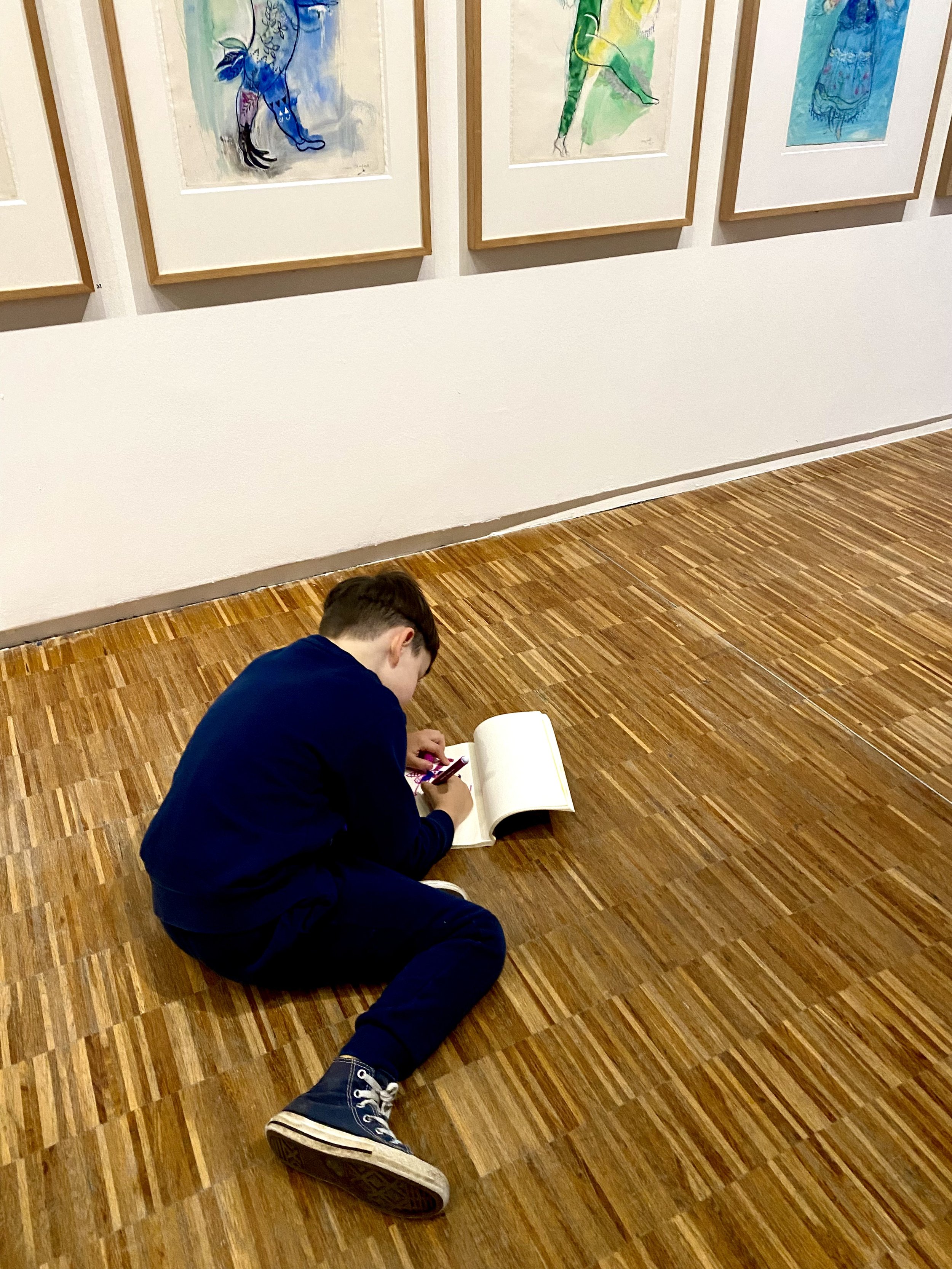In Paris two weeks ago, I made a beeline for an exhibit of Chagall drawings at the Pompidou Centre, and was promptly moved to tears. The colors, the line, the character, the soul, the colors, the colors, THE COLORS! Eyeing them up close and IRL from an inch away (behind glass) only increased my sense of awe at the fluidity of technique, the effortlessness, the perfection.
A young boy sat happily on the floor just below these masterworks, with paper and pens, responding in the most natural way: by making his own art.
This is the unabashed joy of the beginner: inspired by mastery but not intimidated or suffocated by it. This scene was a shorthand expression of an idea that has been lighting me up lately: the paradoxical importance—even for professionals—of being a beginner, helping a beginner, or starting over—“re-beginning”. Our society worships experts, but every last expert was once a beginner! And, having reached mastery, experts are not so different from the beginner as they might appear: they continue channeling the spirit of… the beginner. It’s not so much a contradiction as their secret!
I recently started teaching two young flutists, both age 11. They are beginning to play, I am re-beginning to teach beginners. What a delight! First one sound on the head joint alone, soon five! We play with our “spongey flutes”, 50-cent tubes that serve as flute stand-ins, twirling sticks, conductors batons, and fencing foils. We are composing a cool song based on our three names, and incidentally, learning a full octave’s worth of notes in no time, with hands in perfect position, no less. All three of us are laughing and having fun. At the end of the lesson, one runs off chirping “Bye, Miss Katharine” - my heart melts!
This is just the most obvious of beginnings I’m involved with at the moment. As a beginning-ish composer, I adapted a trio I wrote “on the fly” for a performance with a dozen players—some young experts on their instruments, others adult music lovers who played wooden bird-call whistles I brought along. The piece required following an unorthodox score, which was new to all. Willingness to give it a try, and to work “on the fly”, produced, in the end, a beautiful performance.
I am also re-beginning with the piano, courtesy of Pedro de Alcantara’s liberating new piano method (anti-method?) “Creative Health for Pianists” (Oxford University Press, 2023). I sit with a page open and experiment with his exercises; they are easy, beautiful, my fingers don’t trip, I love the sound. I begin to tweak the chords, to jigger the rhythm, I go off the deep end into the land of harmony—typically only implied when playing flute, but explicit when playing piano.
To tell you the truth, being a flutist, the notes of the piano seem rather direct or OBVIOUS to me, with their fixed pitches, unbendingly stuck on the black or white keys (in contrast to the colors and pitch-bending of the bansuri or shakuhachi flutes, among others)…so I entertain myself dirtying up the chords, piling on dissonances…I make friends with Schoenberg! When I happen upon an interesting chord, I hold my left fingers down on the keys, memorize where the right fingers are, then grab a pencil and scrawl the notes right onto Pedro’s book. It’s ok. He told me it’s ok. Soon I will do something with these chords and progressions; but for the moment, I’m delighting in being a re-beginning pianist, playing in the sandbox of harmony.
It is a challenge for the serious student or professional to retain the best parts of being a beginner, the excitement, while also honing our mastery. We easily end up mired in minutiae, pegging our success on perfectionism, a greedy demon that sucks the fun out of everything.
Settling in to the new season after a bumpy start, what’s really lighting me up is the sheer joy of beginning. On every stretch of the path to mastery, the hallmarks of the beginner can sustain us: open-mindedness, willingness to try and fail and try again, seeking fun and joy rather than tedium, and seeing what happens…on the fly!

